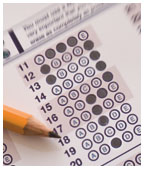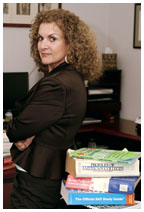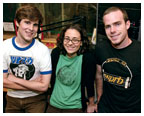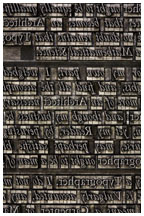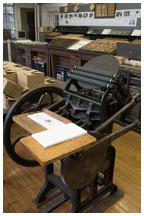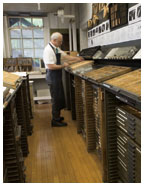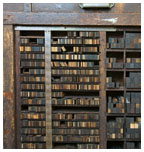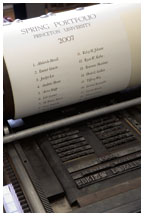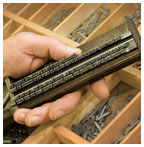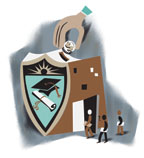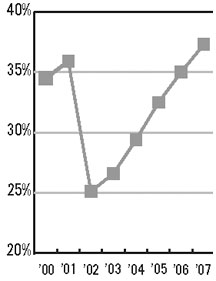
|
September 26, 2007: Notebook
Taking aim at the SAT, ‘mindless’ college ratings
Princeton again tops U.S. News rankings
WPRB kicks off membership drive
Annual Giving sets record, led by Class of ’82
Finance jobs top ’07 work plans
Professor Marta Tienda: ‘The science is clear.’
(PHOTOS: Ricardo Barros (TOP); BEVERLY SCHAEFER) |
Taking aim at the SAT, ‘mindless’ college ratings
In a recent paper about diversity and opportunity in higher education, Princeton sociology professor Marta Tienda and co-author Sigal Alon of Tel Aviv University made two recommendations that border on heresy in the college admission world: To improve diversity, selective colleges should stop taking part in college rankings and de-emphasize the SAT. By relying instead on class rank, high school grades, and other performance-based measures, the authors wrote, universities could draw qualified students from diverse backgrounds without affirmative action.
Using national survey data from high school graduates in the 1980s and 1990s, Tienda and Alon found that colleges have increased their reliance on standardized test scores to screen applicants. The emphasis on test scores, which in part necessitates race-sensitive policies that give underrepresented minorities a “boost” in the admission process, grew in spite of “mounting evidence that test scores have low predictive validity for future academic success,” according to the paper, published in the August edition of American Sociological Review. College rankings contribute to the situation, since schools with higher average SAT scores earn high marks in “student selectivity.” In an interview, Tienda said that by placing too much weight on the SAT, “the ranking game has deflected attention away from the more fundamental goals of education.”
To show an alternative path to diversity that does not rely on test scores, Tienda and Alon cited the case of Texas’ “top 10 percent” law, which guarantees any in-state student in the top decile of his or her high school class admission to either the University of Texas at Austin or Texas A&M (Tienda studied data from the former). The law created a natural experiment for education researchers because for top-10 percent students, SAT scores are ignored. And the results are striking: With the law in place, Texas has assembled diverse classes, expanded the number of Texas high schools sending students to the university, and maintained its graduation rate.
The Texas law has its shortcomings, according to Tienda, who would prefer to see college admission decisions based on a broad portfolio of student qualifications, rather than a single measure such as class rank. But the high school grades that determine class rank, she said, indicate a level of motivation and talent that does not correlate highly with SAT scores. Tienda added that she is not opposed to considering test scores in admissions, but she favors tests that evaluate content, such as Advanced Placement exams or the SAT II.
Tienda and Alon’s paper was embraced by reform advocates like Lloyd Thacker of the Education Conservancy, and the paper’s recommendations — abandoning the college rankings and de-emphasizing the SAT — have been gaining traction as well.
Bates, Bowdoin, and Middlebury are among a slowly growing group of SAT-optional selective colleges, and in June, the presidents of dozens of liberal-arts colleges vowed not to participate in the U.S. News & World Report rankings. The response rate for U.S. News’ peer-assessment survey dropped to its lowest level in history this year, according to The Chronicle of Higher Education. Asked about Princeton’s policy on the peer-assessment survey, University spokeswoman Cass Cliatt ’96 replied: “The surveys are sent to individuals who decide of their own accord whether to complete the surveys.”
Tienda, who has taught at Princeton for a decade and also serves on
the board of Brown University, believes that Ivy League institutions could
have an enormous influence on college rankings and the SAT. “If
I could go speak to the Ivy presidents, I would say one thing,”
she said. “‘You have the opportunity to set the record straight.
The science is clear. Take a stand on this mindless ranking game and take
a stand on this test score that’s being used as the basis for exclusion.
Let us go back to our purpose.’” ![]()
By B.T.

Princeton again tops U.S. News rankings
Amid increasing criticism from educators of U.S. News & World Report’s annual college rankings, Princeton has been ranked No. 1 among national universities for the eighth straight year. Harvard and Yale ranked second and third, respectively, as they did last year.
The magazine’s rankings, released in August, also placed Princeton first in the categories of alumni giving and of students graduating with the least debt (26 percent of the Class of 2005, with an average of $4,370 each). Princeton ranked second behind Harvard for “best value,” with 52 percent of undergraduates in 2006–2007 receiving financial aid that discounted the total cost by an average of 63 percent. But with fewer than 8 percent of undergraduates receiving federal Pell Grants for low-income students in 2005–2006, Princeton was tied for 24th among 26 top-ranked universities for economic diversity.
In other publications, Princeton was named “hottest school for liberal arts” by Newsweek. It was top-ranked in the categories of “school runs like butter” and “students happy with financial aid” by the Princeton Review and was ranked 78th by Washington Monthly, which focuses on social mobility, research, and community service.
In a statement, Princeton officials said they were “gratified”
by the high rankings but suggested that college-bound students should
use a variety of resources to find the best match. ![]()

Wearing WPRB T-shirts from past years are, from left, staff members Michael van Landingham ’08, Madeleine Walsh ’08, and James O’Toole ’08 in the station’s studios in Bloomberg Hall. (FRANK WOJCIECHOWSKI) |
WPRB kicks off membership drive
For nearly three decades, the basic schedule at WPRB has remained consistent — classical music in the morning, jazz at midday, independent rock in the evenings, specialties like world music late at night — and this fall is no exception. But the 67-year-old student-run radio station is making an important shift in the way it pays for that programming. In October, WPRB will hold its first on-air membership drive, kicking off a move to a listener-supported business model.
WPRB has no imminent financial problems, according to Bill Rosenblatt ’83, president of the station’s board of trustees, but the move to draw donor support was driven by economic realities. The station’s advertising base of locally owned businesses in and around Princeton has been shrinking, and expanding the geographic reach of the station’s advertising department was not realistic.
WPRB is a nonprofit organization, as well as one of the relatively few college radio stations permitted to sell airtime to advertisers (its license predates the FCC’s noncommercial FM band). The University does not fund the station, but it does provide WPRB’s working space, a suite of studios and offices in Bloomberg Hall. The Princeton University Investment Co. manages WPRB’s endowment, which pays operating expenses for the station’s transmission facility.
About 100 undergraduate DJs fill most of the station’s airtime, though a handful of nonstudents with ties to the University also host WPRB shows. Regardless of genre, the music played tends to be “not obscure, but definitely off the beaten path,” said station manager Madeleine Walsh ’08, who hosts a classical show.
With a 14,000-watt signal, WPRB’s broadcast radius reaches both Philadelphia and the Jersey shore. The station still covers Princeton events like University Orchestra concerts and football, men’s basketball, and men’s lacrosse games, but its most loyal listeners tune in for the music. To draw more interest in the membership drive, Oct. 7–14, development director Michael van Landingham ’08 and other DJs have lined up live performances by local artists, and donors will be rewarded with WPRB-branded items like T-shirts and tote bags.
Students will be in charge during the membership drive, but Rosenblatt
and other trustees plan to help by answering phones. “Those of us
who pretty much majored in PRB when we were undergrads, will tell you
that the experience we got from being at PRB was life-changing, indelible,
and endlessly valuable,” Rosenblatt said. “We want to ensure
that each year’s round of students who come in have access to the
same experience that we had.” ![]()
By B.T.

|
A passage from Joseph Moxon’s “Mechanick Exercises” (1683), set in type and used in the past for the “History of the Book” course.
A late 19th-century platen press that was found in the basement of Firestone Library.
Robert Milevski, preservation librarian and typography studio manager, standing at the type cabinets as he sets type for his latest letterpress project. (Photographs by Ricardo Barros) |
A bank of wood furniture — hardwood blocks used to fill in the space around the type in the chase.
The cover page for the Spring 2007 portfolio of Professor Emmet Gowin’s photography class comes off the proof press.
A mallet and planers, or hardwood blocks, used to tap the type to make sure that it is at an even height after it has been placed in a chase (the metal frame into which type is locked for printing).
Holding a composing stick (a shallow, adjustable tray in which type is set) containing a couple of long lines of type. |
The old presses and wood cases of metal type in the typography studio at 185 Nassau St. seem like relics from another era. But Robert Milevski, the University’s preservation librarian, sees a “whole continuum” leading to today’s computer age: “It all evolved from writing, from inscription that turned into typography. If we had not discovered movable type, would we have computers today?”
The studio has not received much use in recent years: printing the title page for a photography class portfolio; producing illustrated poetry portfolios for creative writing students; supplementing a course on the history of the book.
Milevski, who has managed the studio since 2001, also produces small custom-printing jobs, such as a four-page “keepsake” of passages from the Iliad, the Odyssey, and the Aeneid in Greek, Latin, and English for an event honoring Professor Robert Fagles in March.
With no formal departmental ties, the studio has led a precarious existence. It was shuttered during the 1990s before it reopened in 1998 with the addition of two presses that had been used for printing jobs at Firestone Library. Later came a proposal to close the studio and use the space for dance, but a “groundswell” of support saved the studio, Milevski said.
This fall the Princeton Atelier program — which brings professional artists to campus to work collaboratively with students and faculty — will use the studio in a course on collotype printing, which combines lithography and photography.
Milevski believes that the studio can continue to play an educational
role: “To students, these things are pretty magical,” he said.
![]()
By W.R.O.
Robert Milevski is collecting experiences of students in the typography studio from the 1970s on, and in the Firestone printing shop in the 1950s and 1960s. Contact him at milevski@princeton.edu.
MORE ON THE TYPOGRAPHY STUDIO: “The bite of the type” by Elyse Graham ’07, click here.

JAMES MCPHERSON, history professor emeritus, will receive the first Pritzker Military Library Literature Award for lifetime achievement in military writing Oct. 6 in Chicago. McPherson, who has published numerous works on the Civil War, won the Pulitzer Prize in 1989 for Battle Cry of Freedom: The Civil War Era. The Pritzker award includes a $100,000 honorarium.
Two chemical engineering majors in the Class of 2002, CHRIS LOOSE and JOEL MOXLEY, are among the founders of a biotechnology startup company that won $250,000 in May in the DFJ East Coast Venture Challenge, a business-plan competition. The company, Cambridge, Mass.-based SteriCoat Corp., has developed a technology to give medical devices an anti-microbial coating to reduce bloodstream infections. SteriCoat also won MIT’s $100K Entrepreneurship Competition.
A team of Princeton undergraduates is one of 36 semifinalists invited to compete Oct. 26–31 in California in a Pentagon-sponsored competition to develop a self-driving vehicle. In the event, called the URBAN CHALLENGE, vehicles will conduct simulated military-supply missions while driving on roads at an urban military base; they must be able to merge into traffic, avoid moving vehicles, and navigate traffic circles. The top 20 teams will compete Nov. 3 for a prize of $2 million.
HALEH ESFANDIARI, a Middle East studies scholar who taught Persian language and literature at Princeton from 1980 to 1994, was released from an Iranian prison Aug. 2 after being held for three months in solitary confinement on charges of endangering Iran’s national security. She returned to work as director of the Middle East program for the Woodrow Wilson International Center in Washington Sept. 10. Esfandiari and the Wilson Center strongly denied the charges. She said she tried to convince her interrogators that she seeks to help women in the Middle East to get involved in the political process. Former Princeton president HAROLD T. SHAPIRO *64 joined with eight university leaders in organizing a national effort to condemn a British academic union’s push to boycott Israeli educational institutions. The initiative resulted in more than 360 college presidents, including President Tilghman, endorsing a statement by Columbia President Lee Bollinger that a boycott is “utterly antithetical to the fundamental values of the academy.”
The associate dean of the Woodrow Wilson School, NOLAN MCCARTY, will serve as acting dean while Dean Anne-Marie Slaughter ’80 is on sabbatical in China. McCarty, the Susan Dod Brown Professor of Politics and Public Affairs, joined the faculty in 2001. His fields of research include U.S. politics, democratic political institutions, and political game theory. Slaughter is spending the 2007–08 academic year at the Shanghai Institute for International Studies.
KAREN J. WEAVER ’94 has been named associate
dean for academic affairs and diversity in the Graduate School, with primary
responsibility for recruiting and retaining underrepresented graduate
students. Weaver previously had been executive director of New Jersey’s
Amistad Commission, overseeing a statewide mandate to integrate African-American
history into the K–12 curriculum. ![]()

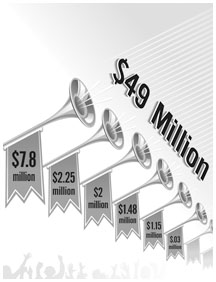 Annual
Giving sets record, led by Class of ’82
Annual
Giving sets record, led by Class of ’82
The Class of 1982 raised $7.8 million for its 25th reunion — a
record for any class – as the 2006–07 Annual Giving campaign
raised $49 million, the highest total in Princeton’s history. The
total was 21 percent more than last year’s record, with 58.5 percent
of undergraduate alumni participating. Four other major reunion classes
set records: 1942, 1952, 1987, and 2002. The giving of graduate alumni
set a record for the fifth straight year. President Tilghman termed the
results “truly extraordinary.” ![]()
(Graphic by Steven Veach)

(Steven Veach) |
Do alumni open their checkbooks in hopes of aiding their children’s chances at admission? Yes, at least at one anonymous university studied by Harvey Rosen, the John L. Weinberg Professor of Economics and Business Policy, and Jonathan Meer ’02, a graduate student at Stanford. In data from “Anon U.,” the authors found a clear “child-cycle pattern” in which alumni increase their giving as their children approach college age — particularly if their kids are applying to mom or dad’s alma mater. The donations decline after the child receives an envelope from the admissions office, and the drop is “far greater” for parents whose children are rejected. The research indicates that while many alumni do give for altruistic reasons, selfish motives also play a role.
Stormy cities
Thunderstorms may grow stronger when they come into contact with cities,
increasing the risk of flash flooding, according to recent research by
graduate student Alexandros Ntelekos; Professor James Smith, the director
of Princeton’s environmental engineering program; and a colleague
from the University of Iowa. Several factors contribute to the problem,
including heat in urban areas, higher concentrations of airborne particles,
and friction caused by storms passing over buildings. In a study published
in the Journal of Hydrometeorology, the authors examined a decade of storm
data from the Baltimore area. Observations and models of one particularly
intense 2004 storm suggested that the city received 30 percent more rain
from the storm than it would have if there were no buildings in the region.
Urbanization, they write, “has made warm-season thunderstorm systems
the principal agent of flash flooding” in Baltimore and other areas
of the eastern United States.
![]()

(Photos by Frank Wojciechowski ) |
The demolition crews were busy on campus during the summer as five dormitories
in Butler College were leveled, top photo, followed by the dismantling
and final razing of the armory, below. More than 2,500 pieces of Butler
dorm furniture will have a new life in Jamaica, where they were shipped
for distribution to residents in need. The Butler dorms will be replaced
in fall 2009 by five brick and limestone residence halls. Excavation work
and casting of the concrete foundation and superstructure will take place
this fall. The armory site, next to Princeton Stadium, will be the location
of the new chemistry building, scheduled for completion in 2010; excavation
and footings work should begin this fall. ![]()

The percentage of women among the graduate students entering the School of Engineering and Applied Science this fall has reached a record high of 31 percent. Nationally, about 20 percent of graduate students in engineering are women.
“We have reached a critical mass of women graduate students, and we expect that number will only grow in the future,” said Stephen Friedfeld, the school’s associate dean for graduate affairs. He said the fields of civil/environmental and chemical engineering have been most popular among women.
Student groups such as Graduate Women in Science and Engineering, the Graduate Engineering Council, and the Graduate Engineering Ambassadors are one factor that makes Princeton attractive to women graduate students, Friedfeld said: “Women have provided a lot of leadership in our student groups.”
On the undergraduate level, more than 40 percent of the incoming freshman
engineering class are women, according to SEAS spokesman Steven Schultz.
![]()

Percentage of class employed at graduation |
Finance jobs top ’07 work plans
The percentage of Princeton seniors who found full-time work before Commencement grew for the fifth consecutive year, according to the Office of Career Services. Aided by a healthy job market, more than 37 percent of the Class of 2007 accepted jobs by late May, up from 35 percent for the Class of 2006.
This year’s new workers will earn an average of $54,318, down slightly from 2006. Career Services reported that philosophy majors will earn the highest average — $71,250 — though only four grads from the department provided salary information. Electrical engineering and operations research and financial engineering were second and third among the top-earning majors.
Financial services again dominated the list of first jobs, accounting for 43.1 percent of all jobs accepted. Investment banking alone drew 148 of the working graduates (35.4 percent). Other popular choices included consulting (16.5 percent) and education (10.8 percent). Sixteen ’07 grads plan to join Teach for America this fall.
Overall, about two-thirds of new grads had found jobs or were pursuing work, including 12 percent who embarked on yearlong internships for nonprofit, public service, or international organizations. Twenty percent planned to attend graduate or professional school. All three figures were similar to those for the Class of 2006.
Of the 2007 graduates who selected graduate schools by May, nearly a
quarter planned to pursue a Ph.D. Harvard remained the top choice for
students heading to graduate or professional programs, followed by Columbia
and Stanford. ![]()
By B.T.

